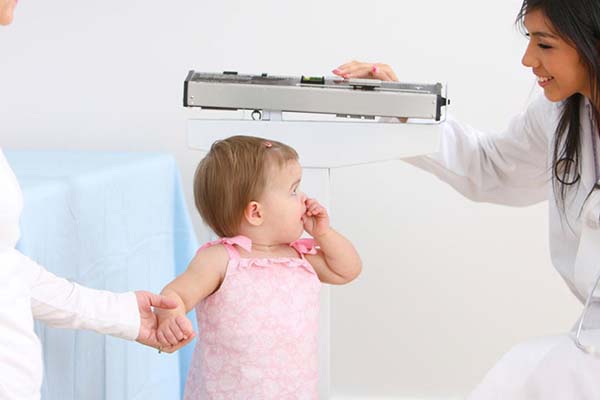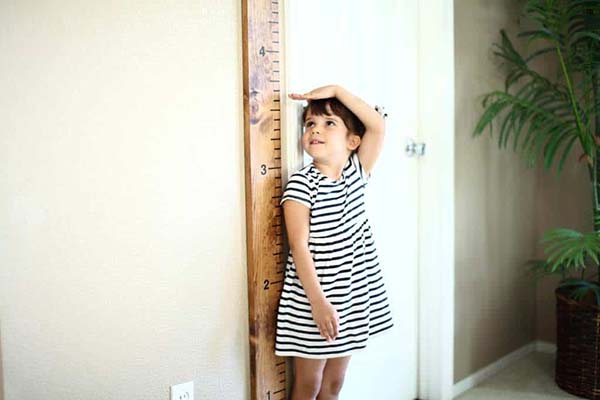Keeping track of a child’s physical growth is so important for any parent. A key part of this is making sure you measure their height the right way. Knowing how to properly measure a child’s height can give you great insights into their general health and how they’re developing. In the following, we’ll discuss the most precise method for measuring a child’s height and explain why it’s so beneficial to do so.
Why is it important to regularly monitor the child’s height?
Closely monitoring your child’s height over time is incredibly important for several significant reasons. This measure allows you, as a parent, and healthcare professionals to track your child’s growth and development patterns. By regularly recording their height, you can identify any deviations from the expected growth curve, which may indicate an underlying health concern that needs attention.
Height is also an essential indicator of your child’s nutritional status. If their height growth seems stunted, it could signal a need to adjust their diet and ensure they are receiving adequate nutrition for healthy development. Similarly, in cases where your child is undergoing medical treatment, tracking their height can help gauge the effectiveness of the therapy.
As your child approaches puberty, height measurements become even more valuable. They can help you anticipate and prepare for the significant growth spurts that occur during this time, which may require adjustments to clothing, sleep schedules, and nutritional needs.
Beyond medical and physical considerations, your child’s height can also provide insights into their genetic growth potential, based on your family’s height patterns. Additionally, height is often an important factor in educational and sports settings, so monitoring it can give you a better understanding of your child’s capabilities and guide their participation in certain activities.
Ultimately, regularly measuring your child’s height is a proactive way to stay involved in their overall growth and well-being. It provides you with valuable information, peace of mind, and the ability to ensure your child is reaching important developmental milestones. By closely tracking this key metric, you can better support your child’s optimal growth and development

What to prepare when measuring your child’s height?
Measuring your child’s height is an important task for parents to undertake, and it requires careful preparation to ensure accurate results. First and foremost, you’ll need to choose an appropriate measuring tool, such as a stadiometer, wall-mounted ruler, or height measuring scale. Make sure the tool is in good working condition and provides clear, precise readings.
Next, you’ll need to select a flat, even surface against the wall for your child to stand on during the measurement. This will help maintain proper posture and alignment. It’s also a good idea to clear the surrounding area of any objects that could interfere with the process.
When it comes to your child’s attire, it’s best to have them stand barefoot and wear light, form-fitting clothing. Shoes, heavy accessories, or bulky clothing can skew the results. Proper posture is also key – instruct your child to stand up straight, with their heels, buttocks, and upper back touching the wall, and their head positioned so their line of sight is parallel to the floor.
If your child is very young or needs assistance, consider having another adult there to help hold them in the correct position. Also, try to measure at the same time of day each session, as there can be slight variations in height throughout the day.
Be sure to record the date and height measurement, either on paper, your computer, or a smartphone. Maintaining consistency in your measurement technique is crucial for accurately tracking your child’s growth over time.
Finally, make the experience positive and stress-free for your child. Offer encouragement and praise to help them feel comfortable and engaged in the process. With the right preparation, you can ensure reliable results that provide valuable insights into your child’s development.
Here is the revised paragraph without explicit references to AI:
When is the best time to measure height?
The optimal time to measure an individual’s height is in the morning, immediately upon waking up. At this time, the spine is well-rested and decompressed, leading to more accurate and consistent measurements. Throughout the day, the effects of gravity and physical activities can cause the spine to compress slightly, potentially resulting in slightly shorter height measurements later in the day.
Measuring height in the morning helps minimize the impact of spinal compression, providing a more reliable baseline for tracking growth over time. It is particularly important to measure height at the same time of day for subsequent measurements to ensure consistency and accurate monitoring of a person’s growth trajectory.
Additionally, measuring height in the morning allows for better comparison with growth charts and age-appropriate height averages, as most reference data are collected using measurements taken in the morning.
The most accurate ways to measure height
Precisely measuring height is crucial for various purposes, including monitoring growth, assessing health, and tracking developmental milestones. Here are the most accurate methods to measure height:
- Stadiometer: A stadiometer is a precise and commonly used tool for height measurement. It consists of a vertical ruler mounted on a stable base with a movable headpiece. The person being measured stands upright against the stadiometer, and the headpiece is lowered gently to rest on the top of their head, providing an accurate height reading.
- Infrared Height Measurement: Infrared height measurement devices use laser technology to measure height quickly and accurately. These devices are becoming increasingly popular for home use due to their ease of use and reliability.
- Medical Scales with Height Measurement Feature: Some digital medical scales come equipped with a height-measuring feature. The person stands on the scale, and it measures both weight and height simultaneously. While convenient, the accuracy of this method may vary depending on the quality of the scale.
- Wall-Mounted Ruler: A wall-mounted ruler is a simple option for measuring height at home. It involves marking the individual’s height on the wall and then measuring the distance from the floor to the mark. While this method can be convenient, it may not be as accurate as using a stadiometer.
To ensure the most accurate height measurement, consider the following tips:
- Proper Posture: Instruct the person being measured to stand straight against the measuring surface with their back against the wall. Their heels, buttocks, and upper back should touch the wall, and their head should be positioned so that the line of sight is parallel to the floor.
- Barefoot Measurement: For accurate results, measure height with the person barefoot. Footwear with significant soles can add extra height and lead to inaccurate measurements.
- Consistent Technique: Use the same measuring tool and follow the same measurement technique for each session to ensure consistency and accurate tracking of growth over time.
- Morning Measurement: For consistent results, measure height in the morning, right after waking up. Spinal compression is minimal at this time, leading to more reliable measurements.
- Repeat Measurements: To ensure accuracy, consider taking multiple measurements and calculating the average height. This helps minimize any potential errors in a single measurement.
By using one of the accurate measurement methods mentioned above and adhering to proper measurement techniques, you can obtain reliable height measurements that are essential for various medical, developmental, and monitoring purposes
Instructions for measuring height without a tape measure
Measuring height without a tape measure can be done using simple objects and basic math. Here’s how you can do it:
Method 1: Wall-Marking Method
- Find a Wall: Locate a straight and flat wall where you can perform the measurement. Make sure there are no objects obstructing the area.
- Stand Against the Wall: Stand upright against the wall with your back straight. Your heels, buttocks, and upper back should touch the wall. Keep your feet together.
- Make a Mark: With a pencil or a small piece of removable tape, make a small horizontal mark on the wall at the highest point of your head.
- Measure the Mark: Use any standard measuring object, such as a book or a ruler, to measure the distance from the floor to the mark you made on the wall.
- Record the Measurement: Note down the measurement you obtained in centimeters or inches.
Method 2: Counting Bricks or Blocks
- Find a Straight Surface: Locate a flat and level surface, such as a concrete floor or pavement, where you can perform the measurement.
- Lie Flat on the Ground: Lie down on your back with your legs extended and your heels touching a straight surface like a wall.
- Mark Your Heel Position: Ask someone to place a small object (like a small brick or block) against your heels to mark the position where your feet end.
- Stand Up Straight: Stand up with your back straight, making sure your heels align with the mark made by the object.
- Measure the Height: Using a measuring tape or any standard measuring object, measure the distance from the mark on the ground to the highest point of your head.
- Record the Measurement: Note down the measurement you obtained in centimeters or inches.

Ensuring Accurate Height Measurements for Children
When measuring a child’s height, it’s critical to follow specific guidelines and consider various factors to obtain the most reliable results. This is essential for monitoring the child’s growth and development effectively.
First and foremost, use a dedicated stadiometer device whenever possible. These specialized tools provide precise height readings and are commonly found in medical facilities. It’s important to have the child stand barefoot, as footwear with thick soles can add extra height and lead to inaccurate measurements.
Positioning the child is also crucial. Have them stand with their back against a flat wall, with their heels, buttocks, and upper back touching the surface. Instruct them to look straight ahead, keeping their head in a neutral position. Proper posture is key – the child should stand upright with relaxed shoulders, avoiding any arching or hunching.
Consistency is paramount. Use the same measurement technique each time, and try to measure the child in the morning, shortly after waking up. Spinal compression is minimal at this time, resulting in more accurate readings. If feasible, take multiple measurements and calculate the average to minimize potential errors.
Be sure to record the date of the measurement, as well as the height reading, for future reference and comparison. Utilize age-appropriate growth charts to assess the child’s progress in relation to their peers.
Finally, create a positive and encouraging environment during the measurement process. This will help the child feel comfortable and cooperative. Avoid scheduling the height check-up right after physically demanding activities, as that could affect the results.
By carefully following these guidelines and considering various influential factors, you can obtain precise and reliable height measurements for your child. This information is crucial for monitoring their growth and development over time
- Related post: Can Meditation Make You Taller?

Erik Kelly with more than 30 years of working in the field of technology and games. Erik Kelly will answer all your questions related to the latest technology products, new game reviews at Timrim.com website.